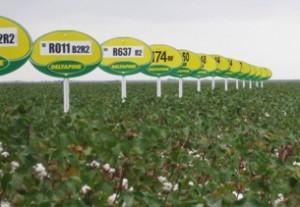Deltapine Relies on Grower Input

The 2010 season marked the last that Deltapine’s gold-standard DP 555 BG/RR would be commercially available, and despite the fact that it had to be bought at paid for in 2009, it remained the number one seller in the Southeast, claiming a 16.8% market share. In 2009, the variety was the number one seller nationally with a 15.98% share.
But Dave Rhylander, Deltapine Market Lead Monsanto says the company is well positioned to fill the void.
“In the Southeast, we’re hearing good things about (DP) 0940 (B2RF) from the Class of ’09. It was the first product we positioned to replace 555,” he says. “In the Class of ’10, (DP) 1048 (B2RF) and (DP) 1050 (B2RF) are just starting to work their way into fields in Georgia, and both of these were also positioned to replace 555.”
In 2009, Deltapine began its New Product Evaluator (NPE) trials where participants are given enough of each variety tested to make at least one module, using their own production techniques and commercial ginning.
When the Class of ’10 was introduced in Charleston, SC, last December, Rhylander said: “The purpose of the NPE trials is to test the new varieties in the real world. Growers told us six-row test plots were good, but, ‘We don’t grow six rows — we grow fields.’ They told us they wanted to take our varieties to their farms to be tested on a large-scale basis. They wanted to grow them just like they would a commercial variety.”
The same was true of the Class of ’09, and those varieties have now had more time to be evaluated Beltwide.
“We’re hearing some great things from the Mississippi Delta on (DP) 0912 (B2RF). We’ve had growers tell us that they’re making up to four bales,” says Rhylander. “So it’s really delivering the yield like we told farmers it would when we launched it.
“And we’re also hearing some good things out of (DP) 0935 (B2RF) in the Coastal Bend area of Texas,” he continues.
As for the Class of ’11, which will be introduced this December in Savannah, GA, Rhylander says, “The NPE trails are going very well. We have seven varieties we’re looking at, and unlike like the last two years, we’re going to have the results out a lot sooner. The last two years we had wet weather and this year it was almost perfect. We’ll be able to make decisions sooner. ”
In 2010, Texas had well over 50% of the nation’s Upland acreage, so it’s no surprise that seed companies are fighting for the high ground.
“One of the products we’re hearing great things about is (DP) 1044 (B2RF). Farmers will come up to us unsolicited and start talking about how good 1044 looks,” says Rhylander. “That makes us very excited. It was a product that performed in the Texas AgriLife Extension Service Trials in 2009. And farmers are telling us that it’s going to be one of the highest — of not the highest — product on their farm this year.”
Deltapine will have four varieties from the Class of ’11 positioned exclusively for the Texas area that Rhylander says are showing promising potential. And there’s a variety from the Class of ’10 that was not commercialized that will be introduced with the Class of ’11 also showing promising potential for the Mid-South and Southeast.
“We didn’t have enough data to make a decision on it because of the wet weather last year, so we chose not to commercialize it,” says Rhylander. “But we put it in the Class of ’11 and farmers who have it this year like it as much as they did last year.
“We’re excited about our new genetics coming in the Class of ’11, and we can’t wait to gather all of the data and make some decisions on which ones to launch, based on what NPE growers are telling us.”









